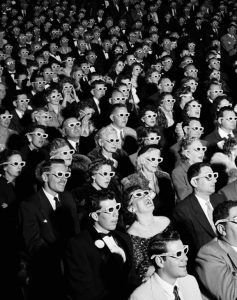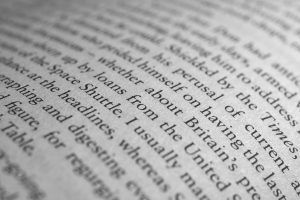by Joshua Wilbur
“How we spend our days is, of course, how we spend our lives.” —Annie Dillard

According to a July 2018 report from Nielsen, American adults now spend more than 11 hours a day on average consuming some form of media. The study considered time spent on television, radio, apps on smartphones, apps on tablets, internet on a computer, game consoles, and other devices. The study excluded print formats, such as books, magazines, and newspapers.
Eleven hours per day is a lot of time. Even if we add print formats to the mix—with the implicit judgement that “book hours” are superior to those dedicated to Netflix or Instagram—the fact remains that the majority of our waking lives is spent in engagement with the creations of other people. More than ever before, we are socially-hungry, story-obsessed, entertainment-seeking creatures.

It’s easy enough to decry this state of affairs. Postmodernists on the Left have long cast a critical glance at consumer culture, commodity fetishism, and the struggle between greedy hoarders of capital and passive wage-earners, who, like the singing Prole woman in Orwell’s 1984, are free to amuse themselves to death. In the 1960s, Guy Debord characterized the modern West as a “Society of the Spectacle” in a book of the same name. According to Debord, “All that was once directly lived has become mere representation.” We prefer action shows to real adventure, rom-coms to actual romance, hi-def images to genuine experiences. Will Self, who just months ago wrote an essay called “The Printed Word in Peril” for Harper’s Magazine, described his impressions of Debord’s treatise in a 2013 article for the Guardian: “Rereading The Society of the Spectacle, I was struck yet again […] by Debord’s astonishing prescience – for what other text from the late 1960s so accurately describes the shit we’re still in?”
And yet, for all the well-placed critique, I can’t help but feel that Debord’s picture of people as ideology-drugged spectators reflects our reality in the worst possible light and, in any case, bemoaning it doesn’t get one very far.
There is no grand revolution on the horizon as far as I can tell. Besides, I like listening to music and podcasts, reading books and magazines, watching movies and television shows, playing games and browsing the internet. Much of this activity enriches my life, even if plenty of it does not. It’s ultimately with a mix of pleasure and guilt that I listen, read, watch, play, and browse for hour upon hour.
Today, we are drenched in culture and blessed (or maybe cursed) with the ability to choose from endless forms and subforms of artistic expression. Selecting from streaming services and online stores is both tantalizing and overwhelming, like an ice cream cone with one too many scoops and now it’s dripping on your hands. Such is the supermarket effect portrayed in Don Delillo’s White Noise. It might simply be that, despite our best intentions, “The world is too much with us,” as Wordsworth suggested long before the invention of the vacuum tube.
From this point of view, one solution to the problem of artistic surplus is to simply refrain, to go outside and breathe in the country air. For most people, who are weighed down with obligations and entrenched in patterns of behavior established long ago, this is much easier said than done. A 2017 study, The Nature of Americans National Report, showed that over half of American adults report spending 5 or fewer hours outside in nature each week. Working in New York this time of year, I’m lucky to find an hour to spend in the park before the sun is down, the weather is bitterly cold, and the big game is on channel 504.

Even if I were to make a deliberate effort to explore the great outdoors (or meditate or exercise or volunteer), I know that I would still spend a disproportionate amount of time in the fantasy worlds of books, movies, and shows. The hours would still add up. The plain-and-simple truth is that almost all of us are addicted to artistic distraction, whether lowbrow or highbrow, Fifty Shades of Grey or My Brilliant Friend. Perhaps addicted is the wrong word: we are, by constitution, storytelling animals, as Jonathan Gottschall argued in his 2012 book, looking for narrative order and harmony in all things.
So if we’re bound to devour whatever cultural material is available to us—albums, films, series, games, podcasts, performances, exhibitions—then shouldn’t we choose well? Is there a way of leaning into our condition that would leave us feeling satisfied, or better yet, improved, or best of all, connected to something larger?
I think this is an important question, but one that provokes a million legitimate answers and therefore none at all, so I can only really hope to answer it for myself.
For me, feeling good about all this consumption comes down to two things: (1) making conscious choices about what I read, watch, listen to, or play and (2) seeking out new experiences rather than idling with what’s familiar. It’s not a complicated formula—search out great art, and aim for novelty.
Of course, I frequently fail. I listen to the same old songs, watch the same Star Trek reruns, and read the same writers and publications. I would like to discover things that are new and surprising and to my taste, but accomplishing this feat can be difficult, not to mention risky. Who wants to waste a Friday night with a crappy movie?
What I’d like to offer here, then, are some of the ways by which I’ve stumbled into rewarding experiences, with links to relevant resources.
I’ll focus on three possible sources for discovering new stuff: recommendation systems, critics, and creators themselves.
Recommendation Systems
The ascendancy of big data is well established. With every click, keystroke, tap, or swipe, data is exchanged, and, more likely than not, someone is paying careful attention. If you’re like me, you probably don’t love the idea of your behavior being so closely monitored, but this under-the-hood data tracking doesn’t feel quite invasive enough for you to stop using Google, Facebook, YouTube, or any number of services.
In fact, we often welcome the use of data. Recommendation Systems now proliferate daily life, offering up targeted suggestions based on users’ prior behavior. Amazon, for example, highlights products that are “Recommended For You” by keeping close tabs on browsing and purchasing histories and then applying a series of collaborative filtering algorithms. (See here for a helpful explainer of what algorithms are and how they work).
![]()
While I’d like to think that I’m rarely swayed to buy a product on the basis of algorithmic operations, I know and readily admit that these systems influence my consumption of media. Netflix provides the most obvious example. In June of last year, Vulture ran an eye-opening feature, “Inside the Binge Factory,” detailing the inner-workings of Netflix’s approach to personalization. As the article’s author writes, “The Netflix algorithm figures out which taste communities a member is in and then pushes the shows it thinks those members will enjoy to the top of their home screen.” The article goes on to quote a Netflix executive—“We have a saying: Your Netflix is not my Netflix”—and further describe the “taste clusters” (there are more than 2,000 “microclusters”) that Netflix uses to categorize viewers and offer up personalized programming recommendations.
If you have a Netflix account—and nearly 150 million people do—then you’ve probably noticed that these suggestions are often pretty good. It didn’t take the Netflix algorithm very long to figure out that I enjoy deadpan comedies, nature documentaries, and science-fiction stories with outer space settings. I now receive a steady stream of movies and shows similar to what I’ve previously watched (and, apparently, what other people in my “cluster” have watched), with Netflix’s in-house content pushed to the front of the line. This makes it relatively easy to find something that I’ll enjoy.
But, to address the question I’ve posed here, is following an algorithm’s recommendation really the best use of my time? Or are there better ways to decide what I’ll consume?
As you’ll have probably guessed, I think there are. Certainly, there are advantages to the recommendation systems. Ease of use, for one thing: they meet us where we already are. What’s more, the truth is that most of us aren’t as unique as we might imagine, and the algorithms’ no-nonsense approach of monitoring users’ choices and providing viewers/listeners/readers with a simple feedback system is quite effective. Spotify, to give another example, knows that I like the Beatles, and so songs by Harry Nilsson fittingly appear on my “Discover Weekly” playlist.
Then again, Spotify doesn’t tell me about Paul McCartney’s love of Nilsson’s music or John Lennon’s unruly friendship with the singer-songwriter during his “lost weekend.” I have to do my own homework to figure out that connection. Which is fine, of course. My point is that these systems are limited in terms of their ability to explain why I might enjoy something. They do little to provide context around how artworks are constructed and in what ways writers, filmmakers, musicians, and others relate to each other. For that sort of insight, more effort is required.
Recommendation systems also tend to offer up plenty of the same. My horizons are rarely broadened in a meaningful way. Since there is a strong connection between seeking novelty and personal well-being, it’s worth making a deliberate effort to spend time with something truly new (as opposed to a carbon copy).
All that said, I have discovered a number of great films, shows, songs, and books thanks to the algorithms, whether I like it or not. Beyond Netflix, here are a few applications and/or sites to consider:
Critics
For at least a few centuries, critics have executed a significant role in popular culture, separating the good from the mediocre and the mediocre from the bad. And for as long as critics have existed, artists have discounted the very notion that someone could make an honest living by passing judgement on the creative acts of others. Following this line of thinking, those who cannot create, criticize.
Critics themselves love to speculate about and justify their own existence. They are by turns brash and guilty, learned and ignorant, authoritative and outmatched. Often in the space of the same review, you’ll see the benefits of criticism as well as its limitations. Whatever the final judgement of its merits may be, I read criticism because I find it useful and interesting.
Barring those not-so-proud moments when I simply feel like reveling in a negative review, I usually seek out critics’ opinions because I want to know not only if something is worth my time but also why. Reading reviews, essays, and articles is a wonderful way to learn more about the context surrounding works of art. Criticism also sustains the feeling that we’re part of a wider cultural community. Criticism is an expansive, social art.

In short, I think most people can benefit from engaging with good criticism, which allows for a deeper appreciation of what’s happening on the screen, on the page, or in a song. In my experience, even if I don’t ultimately enjoy something recommended in a review, I’ve still gained a better understanding of what something is trying to accomplish and why someone else might like it. For example, 2015’s Tomorrowland starring George Clooney (at exactly 50% recommended on Rotten Tomatoes) might be my most-hated movie. I think it’s absolutely awful. And I must’ve read a dozen reviews after seeing it, trying to comprehend how anyone could suggest spending two hours with something so hollow. (I’m still not sure I understand, but I loved reading others’ opinions.)
Of course, some criticism simply reaches too far. Music critics, in particular, often sway into overwritten, purple prose and rely too heavily on biographical anecdote in order to compensate for a lack of knowledge about how songs are actually put together. Obviously, this isn’t true for all publications, but it’s a trend that I’ve noticed. The same thing is common in book reviews, which occasionally deal in judgements of character or probings of social issues without addressing the nuts and bolts of a novel’s design.
In any case, the best critics are stylish, good-humoured, and willing to change their minds. They shed light—sometimes broadly and sometimes in hot, magnified bands— while reminding us that we never read, watch, play, or listen alone. Below are some of my favorite sources of criticism.
Film
The New Biographical Dictionary of Film
Music
All Music (my favorite reviewers are Stephen Thomas Erlewine and Mark Deming)
Robert Christgau’s Consumer Guide
Psychotic Reactions and Carburetor Dung by Lester Bangs
Books
The Norton Anthology of Theory and Criticism
The Los Angeles Review of Books
The New York Times Book Review
Other
Creators
Finally, there are the creators, the artists themselves. Poets, directors, novelists, guitarists, programmers, podcasters, singers, painters, actors: makers of all stripes. If we’re concerned with the question of how to find great art, then shouldn’t we simply ask the artists?
For me, building out from the recommendations of artists whom I already admire has been the most productive method of finding new things that I truly enjoy. It’s a matter of going straight to the source and trusting the experts.
For example, Amoeba Music, an independent chain of music stores based out of California, produces a fantastic web series called “What’s In My Bag?” This award winning series features “artists and tastemakers sharing what they found shopping at Amoeba.” It’s a simple set-up: interview musicians who walk through the door, and ask them about what they purchased and why.
Hearing artists that I love talk about their influences is endlessly fascinating. Through the Amoeba interviews, I’ve discovered dozens of new musical artists across multiple genres. And I’ve gained a better understanding of how musicians incorporate the sounds of others into their own songs, stretching back across the decades.
Interviews provide the best window into the tastes of creators, allowing them to communicate openly about what they enjoy and why. Artists are less constrained than critics, able to speak their minds without fear of appearing unfashionable. And they carry the ultimate weight of authority because they have created great things and understand the rules of the game.
Below are some of my favorite sources for discovering the thoughts, opinions, and tastes of artists, who offer insight into the nature of their work as no algorithm ever will. I hope these resources provide a useful starting point for anyone hoping to fill their days with great art, straight from those who know best.
Film
Conversations with Filmmakers Series
Sight and Sound Directors’ Top 100
Who The Devil Made It: Conversations with Legendary Film Directors by Peter Bogdanovich
Hitchcock by Francois Truffaut
Sculpting in Time by Andrey Tarkovsky
Music
The Rolling Stone Interviews: Talking with the Legends of Rock & Roll edited by Joe Levy
Bob Dylan: The Essential Interviews edited by Jonathan Cott
Books
The New Yorker This Week in Fiction
The Top Ten: Writers Pick Their Favorite Books edited by J. Peder Zane
Other
This American Life Staff Recommendations
